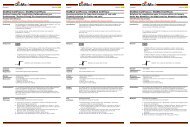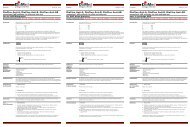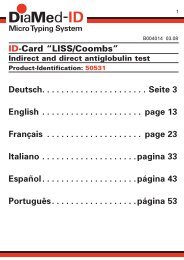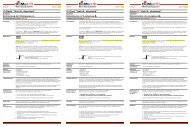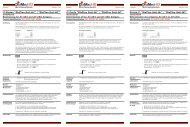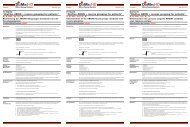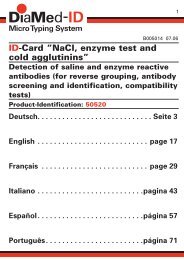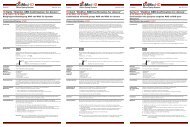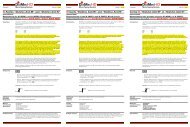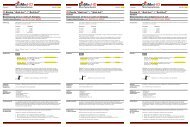ID-Card “DiaClon ABO/Rh for newborns”
ID-Card “DiaClon ABO/Rh for newborns”
ID-Card “DiaClon ABO/Rh for newborns”
Create successful ePaper yourself
Turn your PDF publications into a flip-book with our unique Google optimized e-Paper software.
Deutsch B001028 04.07 English B001028 04.07 Français B001028 04.07<strong>ID</strong>-Karte <strong>“DiaClon</strong> <strong>ABO</strong>/<strong>Rh</strong> <strong>for</strong> <strong>newborns”</strong>A, B, AB, DVI+, ctl/ DATBestimmung der <strong>ABO</strong>/<strong>Rh</strong> Blutgruppen bei Neugeborenenmit dem direkten Antiglobulintest (DAT)Produkt-Identifikation: 50961<strong>ID</strong>-<strong>Card</strong> <strong>“DiaClon</strong> <strong>ABO</strong>/<strong>Rh</strong> <strong>for</strong> <strong>newborns”</strong>A, B, AB, DVI+, ctl/ DATDetermination of the <strong>ABO</strong>/<strong>Rh</strong> blood groups with directantiglobulin test (DAT) <strong>for</strong> newbornsProduct-Identification: 50961Carte-<strong>ID</strong> <strong>“DiaClon</strong> <strong>ABO</strong>/<strong>Rh</strong> <strong>for</strong> <strong>newborns”</strong>A, B, AB, DVI+, ctl/ DATDétermination des groupes sanguins <strong>ABO</strong>/<strong>Rh</strong> pournouveau-nés, avec le test direct à l‘antiglobuline (TDA)Identification de produit: 50961EinleitungAnti-A-, Anti-B- und Anti-AB-Testseren werden für die Bestimmung der A/B-Antigene benötigt. Da dieAntigene A und B bei der Geburt noch nicht vollständig entwickelt sind, können die Reaktionenschwächer sein als mit Erwachsenen-Bluten. Untergruppen können oft nicht bestimmt werden.IntroductionAnti-A, anti-B and anti-AB test sera are necessary to detect the presence or absence of A/B antigens onhuman red cells. Since A and B antigens are not fully developed at birth, weaker reactions may occurwith red cells of newborns than of adults and subgroups often cannot be identified.IntroductionLes sérums-tests anti-A, anti-B et anti-AB sont nécessaires pour détecter la présence ou l’absence desantigènes A/B sur les hématies humains. A la naissance, les antigènes A et B ne sont pas complètementdéveloppés; des réactions affaiblies peuvent donc se produire avec le sang des nouveau-nés et, donc,les sous-groupes ne peuvent être toujours identifiés.Das Serum von Erwachsenen enthält Antikörper gegen die auf Erythrozyten nicht vorhandenenAntigene A und B. Diese Antikörper treten nach den ersten 4 bis 6 Lebensmonaten auf. Entsprechendkann die Serumgegenprobe bei Neugeborenen nicht durchgeführt werden. Es ist deshalb angezeigt, diebeim Neugeborenen bestimmte Blutgruppe nach 2 bis 4 Jahren zu bestätigen, wenn die Antigene A undB voll entwickelt sind.The serum of adults contains antibodies directed against the A and B antigens absent from their ownred cells. Both antibodies appear after the first 4 to 6 months of life. As a result, reverse grouping is notusually undertaken on newborn blood samples. Confirmation of the newborn’s blood group is indicatedwhen the A and B antigen expression is fully developed (2-4 years).Le sérum des adultes contient des anticorps anti-A et anti-B lorsque les antigènes correspondantssont absents sur les hématies. Ces anticorps n’apparaissent que 4 à 6 mois après la naissance. Parconséquent, l’épreuve sérique (test de Simonin) n’est habituellement pas réalisé avec le sérum dunouveau-né. Il est donc recommandé de confirmer le groupe <strong>ABO</strong> du nouveau-né quand l’expressiondes antigènes A et B est complètement développée (dès l’âge de 2 à 4 ans).Das Antigen D wie auch schwaches D ist bei der Geburt vollständig entwickelt. Bei <strong>Rh</strong>-negativen Mütternist die Bestimmung des <strong>Rh</strong>D und des schwachen D beim Neugeborenen unerlässlich.The D antigen as well as weak D is fully developed at birth. The determination of the <strong>Rh</strong>D status of thenewborn’s blood group is important if the mother is <strong>Rh</strong>D negative.Les antigènes <strong>Rh</strong>D et D faible sont entièrement développés à la naissance. La détermination du <strong>Rh</strong>D et Dfaible est indispensable chez le nouveau-né si la mère est <strong>Rh</strong>D négatif.Die Durchführung des direkten Antiglobulintests (DAT) bei Neugeborenen ist Routinesache, da eswichtig ist festzustellen, ob die Erythrozyten des Neugeborenen mit Antikörpern in utero beladen sind.A direct antiglobulin test (DAT) on newborn blood samples has become a standard procedure, since it isof importance to know if the newborn’s red cells have been coated with maternal antibodies in-utero.Le test direct à l’antiglobuline (TDA) avec les hématies du nouveau-né est une procédure établie,puisqu’il est important de savoir si les hématies sont sensibilisées par les anticorps maternels in utéro.ReagenzienReagentsRéactifs<strong>ID</strong>-Karte <strong>“DiaClon</strong> <strong>ABO</strong>/<strong>Rh</strong> <strong>for</strong> <strong>newborns”</strong> enthält monoklonales Anti-A [Zellinie LM 297/628 (LA-2)],Anti-B [Zellinie LM 306/686 (LB-2)], Anti-AB [Zellinien ES131 (ES-15) + Birma-1 + ES-4] und Anti-D(Zellinien ESD-1M + 175-2) in der Gelmatrix. Das Mikroröhrchen (ctl) dient zur negativen Kontrolle.Das Anti-Humanglobulinserum ist eine Mischung aus Kaninchen-Anti-IgG und monoklonalem Anti-C3d(Zellinie C139-9).<strong>ID</strong>-<strong>Card</strong> <strong>“DiaClon</strong> <strong>ABO</strong>/<strong>Rh</strong> <strong>for</strong> <strong>newborns”</strong> contains monoclonal anti-A [cell line LM 297/628 (LA-2)],anti-B [cell line LM 306/686 (LB-2)], anti-AB [cell lines ES131 (ES-15) + Birma-1 + ES-4] and anti-D (celllines ESD-1M + 175-2), within the gel matrix. The microtube (ctl) is the negative control.The anti-human globulin serum is a blend of rabbit anti-IgG and monoclonal anti-C3d (cell line C139-9).Carte-<strong>ID</strong> <strong>“DiaClon</strong> <strong>ABO</strong>/<strong>Rh</strong> <strong>for</strong> <strong>newborns”</strong> contient de l’anti-A monoclonal [lignée cellulaire LM 297/628(LA-2)], anti-B [lignée cellulaire LM 306/686 (LB-2)], anti-AB [lignées cellulaires ES131 (ES-15) + Birma-1+ ES-4] et anti-D [lignées cellulaires ESD-1M + 175-2] inclus dans le gel. Le microtube (ctl) est le contrôlenégatif.L’antiglobuline humaine est un mélange d’anti-IgG de lapin et d’anti-C3d monoclonal (lignée cellulaireC139-9).Konservierungsmittel: < 0,1% NaN 3 .Preservative: < 0,1% NaN 3 .Conservateurs: < 0,1% NaN 3 .Achtung: Alle Reagenzien sollten als potentiell infektiös gehandhabt werden.Caution: All reagents should be treated as potentially infectious.Attention: Tout réactif doit être considéré comme potentiellement infectieux.Nicht in der Nähe von Hitzequellen, Klimaanlagen oder Lüftungsgängen lagern.Stabilität: siehe Verfallsdatum auf dem Etikett.Do not store near any heat, air conditioning sources or ventilation outlets.Stability: see expiry date on label.Ne pas stocker à proximité d’une source de chaleur, d’une climatisation ou unesortie de ventilation.Stabilité: voir la date de péremption sur l’étiquette.ZuätzlichbenötigteReagenzien<strong>ID</strong>-Diluent 2: Modifiziertes LISS zur Herstellung der Erythrozytensuspensionen.(siehe diesbezügliche Packungsbeilage)Additionalreagentsrequired<strong>ID</strong>-Diluent 2: modified LISS <strong>for</strong> red cell suspensions.(see related package insert)Réactifssupplémentairesnécessaires<strong>ID</strong>-Diluent 2: LISS modifié pour suspensions d’hématies.(voir mode d’emploi correspondant)Weitereer<strong>for</strong>derlicheMaterialien• <strong>ID</strong>-Dispenser• <strong>ID</strong>-Pipetor• <strong>ID</strong>-Tips (Pipetor-Spitzen)• Suspensionsröhrchen• <strong>ID</strong>-Arbeitsplatz• <strong>ID</strong>-Zentrifuge 6, 12 oder 24Furthermaterialsrequired• <strong>ID</strong>-Dispenser• <strong>ID</strong>-Pipetor• <strong>ID</strong>-Tips (pipetor tips)• Tubes <strong>for</strong> suspensions• <strong>ID</strong>-Working table• <strong>ID</strong>-Centrifuge 6, 12 or 24Matériauxsupplémentairesnécessaires• <strong>ID</strong>-Dispenser• <strong>ID</strong>-Pipetor• <strong>ID</strong>-Tips (cônes pour pipette)• Tubes pour suspensions• <strong>ID</strong>-Table de travail• <strong>ID</strong>-Centrifuge 6, 12 ou 24ProbenmaterialBlutproben werden nach allgemeingültigen Entnahmeverfahren gewonnen.Nabelschnurproben oder Fersenpunktate können verwendet werden. Die Erythrozyten müssen vorGebrauch nicht gewaschen werden (siehe “Anmerkungen”). Wenn Nabelschnurproben verwendetwerden, sollte darauf geachtet werden, eine Kontamination mit Wharton-Sulze zu vermeiden.Sample materialDraw blood samples using acceptable phlebotomy techniques.Cord or heel prick samples may be used. It is normally not necessary to wash the cells be<strong>for</strong>e use (see“Remarks”). Where cord samples are used, care must be taken to avoid contamination with Wharton’sjelly.EchantillonsPrélever les échantillons selon des techniques de phlébotomie correctes.Sang de cordon ombilical ou sang capillaire prélevé au talon peuvent être utilisés. Normalement il n’estpas nécessaire de laver les hématies avant utilisation (voir “Remarques”). Si du sang de cordon estutilisé, éviter la contamination par la gelée de Wharton.Die Probengewinnung sollte in Citrat, EDTA oder CPD-A erfolgen. Um verlässliche Resultate zu erhalten,empfiehlt sich die Verwendung von frisch entnommenem Blut.Preferably, blood samples should be drawn into Citrate, EDTA or CPD-A. For reliable results, use offreshly collected blood is indicated.Les échantillons doivent être prélevés en citrate, EDTA ou CPD-A. Pour des résultats fiables, utiliser dusang frais.Vorbereitung derBlutprobeEine 0,8%ige Erythrozytensuspension in <strong>ID</strong>-Diluent 2 wie folgt herstellen:Diluent vor Gebrauch auf Raumtemperatur bringen.1. 1,0 mL <strong>ID</strong>-Diluent 2 in ein sauberes Röhrchen pipettieren.2. 10 L µL Erythrozytenkonzentrat oder 20 L µL Vollblut hinzugeben; leicht mischen.Preparation ofblood samplePrepare a 0,8% red cell suspension in <strong>ID</strong>-Diluent 2 as follows:Allow the diluent to reach room temperature be<strong>for</strong>e use.1. Dispense 1,0 mL of <strong>ID</strong>-Diluent 2 into a clean tube.2. Add 10 L µL of packed red cells or 20 L µL of whole blood, mix gently.Préparation del’échantillon desangPréparer une suspension d’hématies à 0,8% en <strong>ID</strong>-Diluent 2, comme suit:Ramener le diluant à température ambiante avant utilisation.1. Distribuer 1,0 mL d’<strong>ID</strong>-Diluent 2 dans un tube propre.2. Ajouter 10 L µL de culot d’hématies ou 20 L µL de sang total, mélanger doucement.Die Erythrozytensuspension kann so<strong>for</strong>t verwendet werden.The cell suspension may be used immediately.La suspension d’hématies peut être utilisée immédiatement.KontrollenBekannte Antigen-positive und -negative Erythrozyten sollten in Übereinstimmung mit dengültigen Richtlinien zur Qualitätssicherung mitgeführt werden.ControlsKnown positive and negative samples should be included in accordance with the relevant guidelines ofquality assurance.ContrôlesDes échantillons positifs et négatifs connus devront être inclus en concordance avec les réglementationsrégissant l‘assurance qualité.TestdurchführungKeine <strong>ID</strong>-Karten benutzen mit Anzeichen von Austrocknung, Luftblasen, beschädigter Versiegelung oderTropfen des Gels bzw. des Überstandes im oberen Teil der Mikrokammer oder auf der Unterseite derVersiegelung.Test procedureDo not use <strong>ID</strong>-<strong>Card</strong>s which show signs of drying, have bubbles, damaged seals, drops of gel orsupernatant in the upper part of the microtubes or on the underside of the aluminium foil.MéthodeNe pas utiliser les cartes <strong>ID</strong> présentant des signes de desséchement, des bulles d‘air dans le gel, unsystème de fermeture endommagé, des goutelettes de gel ou de surnageant sur les paroies supérieuresdes micotubes ou sur la face interne de la languette d‘aluminium.1. Die <strong>ID</strong>-Karte mit den Patienten- oder Spenderdaten beschriften.2. Aluminiumfolie von den benötigten Mikroröhrchen in aufrechter Kartenposition entfernen.3. 50 µL der Erythrozytensuspension in alle 6 Mikroröhrchen der <strong>ID</strong>-Karte pipettieren.4. <strong>ID</strong>-Karte 10 Minuten in der <strong>ID</strong>-Zentrifuge zentrifugieren.5. Reaktionen ablesen und aufzeichnen.1. Identify the <strong>ID</strong>-<strong>Card</strong> with the unique patient or donor number/details as appropriate.2. Remove the aluminium foil from as many microtubes as required by holding the <strong>ID</strong> card in theupright position.3. Pipette 50 µL of the red cell suspension to all 6 microtubes of the <strong>ID</strong>-<strong>Card</strong>.4. Centrifuge the <strong>ID</strong>-<strong>Card</strong>s <strong>for</strong> 10 minutes in the <strong>ID</strong>-Centrifuge.5. Read and record the results.1. Identifier la carte <strong>ID</strong> avec le numéro d’enregistrement unique du patient ou donneur / toutesidentifications pertinentes.2. Décoller la languette d‘aluminium des microtubes nécessaires en tenant la carte <strong>ID</strong> en positionverticale.3. Pipetter 50 µL de la suspension d’hématies à tous les microtubes de la carte-<strong>ID</strong>.4. Centrifuger la carte-<strong>ID</strong> 10 minutes dans l’<strong>ID</strong>-Centrifuge.5. Lire et noter les réactions.
Français B001028 04.07 English B001028 04.07 Deutsch B001028 04.07Interprétationdes résultatsA) Principe [2]Positif:Négatif:Hématies agglutinées <strong>for</strong>mant une ligne rouge à la surface du gel ou des agglutinatsdispersés dans le gel.Hématies en culot compact au fond du microtube.Interpretationof resultsA) Principle [2]Positive:Negative:Agglutinated cells <strong>for</strong>ming a red line on the surface of the gel or agglutinates dispersedin the gel.Compact button of cells on the bottom of the microtube.Interpretationder ErgebnisseA) Prinzip [2]Positiv:Negativ:Agglutinierte Erythrozyten bilden eine rote Linie auf dem Gel oder sind im Gel verteilt.Kompaktes Erythrozytensediment am Boden des Mikroröhrchens.B) Réactions des groupes sanguins <strong>ABO</strong>B) Reactions <strong>for</strong> blood groups <strong>ABO</strong>B) Reaktionen der <strong>ABO</strong> BlutgruppenAnti-A Anti-B Anti-AB Groupe sanguinAnti-A Anti-B Anti-AB Blood groupAnti-A Anti-B Anti-AB Blutgruppe+ à ++++ négatif + à ++++ A+ to ++++ negative + to ++++ A+ bis ++++ negativ + bis ++++ Anégatif + à ++++ + à ++++ Bnegative + to ++++ + to ++++ Bnegativ + bis ++++ + bis ++++ B+ à ++++ + à ++++ + à ++++ AB+ to ++++ + to ++++ + to ++++ AB+ bis ++++ + bis ++++ + bis ++++ ABnégatif négatif négatif Onegative negative negative Onegativ negativ negativ OEn présence d‘antigènes ayant une expression faible ou très faible la réaction peut être négative.L‘anti-B monoclonal ne réagit pas avec les antigènes B acquis.In the presence of weak or very weakly expressed antigens the reaction can be negative. The anti-B ofmonoclonal origin does not react with the acquired B antigen.Bei Vorhandensein von schwach bis sehr schwach exprimierten Antigenen kann eine negative Reaktionvorliegen. Das Anti-B monoklonalen Ursprungs reagiert nicht mit dem erworbenen B-Antigen.Important: Le microtube ctl doit montrer une réaction négative. Si le ctl est positif, la détermination <strong>ABO</strong>ne peut être validée. Répéter le test comme décrit sous “Remarques 1.”.Important: The microtube ctl must show a negative reaction. If the ctl is positive, the <strong>ABO</strong> determinationis not valid. Repeat the test as described under “Remarks 1.”.Wichtiger Hinweis: Das Mikroröhrchen ctl muss eine negative Reaktion aufweisen. Falls ctl positiv ist, istdie Blutgruppenbestimmung ungültig. Der Test ist wie unter “Anmerkungen 1.” beschrieben zuwiederholen.C) Réactions pour <strong>Rh</strong>DC) Reactions <strong>for</strong> <strong>Rh</strong>DC) Reaktionen für <strong>Rh</strong>D+++ à ++++ ± à ++* négatif+++ to ++++ ± to ++* negative+++ bis ++++ ± bis ++* negativ<strong>Rh</strong>D positif <strong>Rh</strong>D faible positif <strong>Rh</strong>D négatif<strong>Rh</strong>D positive <strong>Rh</strong>D weak positive <strong>Rh</strong>D negative<strong>Rh</strong>D positiv <strong>Rh</strong>D schwach positiv <strong>Rh</strong>D negativ* ±, des traces ou des réactions faibles seront sujet à des investigations complémentaires afin dedifférencier un D faible d’un D partiel, selon le type d’échantillon analysé.* ±, trace or weak reactions should be subject to further investigations to distinguish between weak andpartial D types as appropriate <strong>for</strong> the category of sample being tested.* Bei schwachen, ± oder Spuren von Reaktionen sollten weiterführende Untersuchungen zurUnterscheidung zwischen schwachen und Kategorien der partiellen D Typen durchgeführt werden.Le sérum test Anti-D a été sélectionné également pour détecter les variants DVI. Quelques antigènesvariants DVI peuvent donner des réactions très faibles.The anti-D test sera were selected so as to react with DVI variants. Some DVI variants can give veryweak reaction.Das Anti-D Testserum wurde so ausgewählt, dass es mit DVI-Varianten reagiert, jedoch können mancheDVI-Varianten schwach positive Reaktionen zeigen.Important: Le microtube ctl doit montrer une réaction négative. Si le ctl est positif, la détermination <strong>Rh</strong>Dne peut être validée. Répéter le test comme décrit sous “Remarques 1.”.Important: The microtube ctl must show a negative reaction. If the ctl is positive, the <strong>Rh</strong>D determinationis not valid. Repeat the test as described under “Remarks 1.”.Wichtiger Hinweis: Das Mikroröhrchen ctl muss eine negative Reaktion aufweisen. Falls ctl positiv ist, istdie <strong>Rh</strong>D-Bestimmung ungültig. Der Test ist wie unter “Anmerkungen 1.” beschrieben zu wiederholen.D) Réactions pour le test direct à l’antiglobuline (TDA)D) Reactions <strong>for</strong> the direct antiglobulin test (DAT)D) Reaktionen im direkten Antiglobulintest (DAT)Une réaction négative indique l’absence d’anticorps détectables sur les hématies du nouveau-né.A negative reaction indicates the absence of detectable antibodies on the newborn’s red cells.Eine negative Reaktion weist auf Abwesenheit nachweisbarer Antikörper auf den Erythrozyten desNeugeborenen hin.Une réaction positive (± à ++++) indique que les hématies du nouveau-né sont sensibilisées (anticorpsfixés sur les hématies).A positive reaction (± to ++++) indicates that the newborn’s red cells are sensitized (red cells coated withantibodies).Eine positive Reaktion (± bis ++++) bedeutet, dass die Erythrozyten des Neugeborenensensibilisiert sind (an der Oberfläche der Erythrozyten gebundene Antikörper).Remarques1. Le microtube (ctl) doit toujours montrer une réaction négative. Si le contrôle négatif est positif,procéder comme suit:- Laver d’abord les hématies en solution isotonique (ou en <strong>ID</strong>-Diluent 2) avant de préparer lasuspension d‘hématies à 0,8%.- Procéder ensuite comme décrit dans les paragraphes: “Préparation de l’échantillon de sang” et“Méthode”.2. Si le contrôle négatif (ctl) reste positif, l’interprétation des groupes <strong>ABO</strong> et <strong>Rh</strong>D ne peut être assuréeet des investigations supplémentaires sont nécessaires.Remarks1. The negative control (ctl) must always show a negative reaction. If the negative ctl is positive,proceed as follows:– Wash the red cells first with isotonic saline solution (or <strong>ID</strong>-Diluent 2) be<strong>for</strong>e preparing the 0,8% cellsuspension.– Then proceed as under “Preparation of blood sample” and “Test procedure”.2. If the negative control remains positive, safe interpretation of the <strong>ABO</strong> and <strong>Rh</strong>D groups cannot bemade and further investigation is required.Anmerkungen1. Die negative Kontrolle (ctl) muss immer eine negative Reaktion zeigen. Falls sie positiv ist, wie folgt<strong>for</strong>tfahren:- Die Erythrozyten zuerst mit isotonischer Kochsalzlösung (oder <strong>ID</strong>-Diluent 2) waschen, bevor die0,8%ige Erythrozytensuspension zubereitet wird.- Fortfahren wie unter “Vorbereitung der Blutprobe” und “Testdurchführung” beschrieben.2. Bleibt die negative Kontrolle ctl weiterhin positiv, kann keine sichere Interpretation derBlutgruppen <strong>ABO</strong> und <strong>Rh</strong>D gemacht werden, weitere Untersuchungen sind notwendig.Limitesa) Les cartes-<strong>ID</strong> présentant des bulles d‘air dans le gel ou des goutelettes dans la partie supérieur desmicrotubes ou sur la languette métallique doivent être centrifugées avant utilisation.b) Des contaminations, bactériennes ou autres, du matériel utilisé peuvent provoquer des résultatsfaussement positifs ou faussement négatifs.c) Des résidus de fibrine dans la suspension d’hématies peuvent emprisonner quelques cellules nonagglutinées, <strong>for</strong>mant ainsi une fine ligne rose à la surface du gel, alors que la plupart des hématiessont dans le fond du microtube aprés centrifugation.d) L’observation stricte des méthodes et l’emploi de l’équipement recommandé sont essentiels.L’équipement doit être régulièrement contrôlé selon les procédures des GLP.e) L’utilisation de diluants autres que l’<strong>ID</strong>-Diluent 2 peut modifier les résultats.f) Des suspensions d’hématies trop concentrées ou trop diluées peuvent provoquer des résultatsaberrants.Limitationsa) <strong>ID</strong>-<strong>Card</strong>s which show air bubbles in the gel or drops in the upper part of the microtubes and/or theseal, must be centrifuged be<strong>for</strong>e use.b) Bacterial or other contamination of materials used can cause false positive or false negative results.c) Fibrin residues in the red cell suspension may trap non-agglutinated cells presenting a fine pink lineon top of the gel while most of the cells are on the bottom of the microtube after centrifugation.d) Strict adherence to the procedures and recommended equipment is essential. The equipment shouldbe checked regularly according to GLP procedures.e) Use of suspension solutions other than <strong>ID</strong>-Diluent 2 may modify the reactions.f) Too heavy or too weak red cell suspensions can cause aberrant results.Einschränkungena) <strong>ID</strong>-Karten mit Luftblasen im Gel oder Tropfen im oberen Bereich der Mikrokammern und/oderVersiegelung müssen vor Gebrauch zentrifugiert werden.b) Bakterielle oder andere Kontaminationen des verwendeten Materials können falsch positive oderfalsch negative Ergebnisse verursachen.c) Fibrinreste in der Erythrozytensuspension können nicht-agglutinierte Erythrozyten verkleben, diesich als feine rosa Linie auf der Geloberfläche darstellen, während die meisten Erythrozyten nachZentrifugation am Boden der Mikroröhrchen ein kompaktes Sediment bilden.d) Striktes Befolgen der Anleitungen und Verwendung des er<strong>for</strong>derlichen Arbeitmaterials sind unerlässlich.Das Arbeitsmaterial sollte regelmässig entsprechend der GLP-Richtlinien überprüft werden.e) Der Gebrauch anderer Lösungen als <strong>ID</strong>-Diluent 2 für die Erythrozytensuspensionen kann dieReaktionen beeinflussen.f) Zu starke oder zu schwache Erythrozytensuspensionen können abnormale Reaktionen hervorrufen.Bibliographie 1. Mollison, P.L., Engelfriet, C.P. and Contreras, M.: Blood Transfusion in Clinical Medicine, 10 th ed. 1997;Blackwell Scientific Publications, Ox<strong>for</strong>d.2. American Association of Blood Banks: Technical Manual; 11 th ed. 1993.3. Lapierre, Y., Rigal, D., Adam, J. et al.: The gel test; A new way to detect red cell antigen-antibodyreactions. Transfusion 1990; 30: 109–113.Produits Carte-<strong>ID</strong> <strong>“DiaClon</strong> <strong>ABO</strong>/<strong>Rh</strong> <strong>for</strong> <strong>newborns”</strong> 4 x 12 . . . . . . . . . . . . . . . . . . . REF 00104724 x 12 . . . . . . . . . . . . . . . . . . . REF 00104860 x 12 . . . . . . . . . . . . . . . . . . . REF 001049112 x 12 . . . . . . . . . . . . . . . . . . . REF 001050Ces produits sont garantis quant à leurs propriétés et qualités stipulées sur l’étiquette et dans le modeopératoire. Le fabricant décline toute responsabilité pour les cas où ces produits seraient employés ouvendus à d’autres usages.Bibliography 1. Mollison, P.L., Engelfriet, C.P. and Contreras, M.: Blood Transfusion in Clinical Medicine, 10 th ed. 1997;Blackwell Scientific Publications, Ox<strong>for</strong>d.2. American Association of Blood Banks: Technical Manual; 11 th ed. 1993.3. Lapierre, Y., Rigal, D., Adam, J. et al.: The gel test; A new way to detect red cell antigen-antibodyreactions. Transfusion 1990; 30: 109–113.Products <strong>ID</strong>-<strong>Card</strong> <strong>“DiaClon</strong> <strong>ABO</strong>/<strong>Rh</strong> <strong>for</strong> <strong>newborns”</strong> 4 x 12 . . . . . . . . . . . . . . . . . . . REF 00104724 x 12 . . . . . . . . . . . . . . . . . . . REF 00104860 x 12 . . . . . . . . . . . . . . . . . . . REF 001049112 x 12 . . . . . . . . . . . . . . . . . . . REF 001050These products are guaranteed to per<strong>for</strong>m as described on the label and in the instruction sheet. Themanufacturer declines all responsibility arising out of the use or sale of these products in any way or <strong>for</strong>any purpose other than those described therein.Literatur 1. Mollison, P.L., Engelfriet, C.P. and Contreras, M.: Blood Transfusion in Clinical Medicine, 10 th ed. 1997;Blackwell Scientific Publications, Ox<strong>for</strong>d.2. American Association of Blood Banks: Technical Manual; 11 th ed. 1993.3. Lapierre, Y., Rigal, D., Adam, J. et al.: The gel test; A new way to detect red cell antigen-antibodyreactions. Transfusion 1990; 30: 109–113.Produkte <strong>ID</strong>-Karte <strong>“DiaClon</strong> <strong>ABO</strong>/<strong>Rh</strong> <strong>for</strong> <strong>newborns”</strong> 4 x 12 . . . . . . . . . . . . . . . . . . . REF 00104724 x 12 . . . . . . . . . . . . . . . . . . . REF 00104860 x 12 . . . . . . . . . . . . . . . . . . . REF 001049112 x 12 . . . . . . . . . . . . . . . . . . . REF 001050Für diese Produkte wird nur Garantie übernommen, wenn sie gemäss den Angaben auf dem Etikett undder Anwendungsvorschrift verwendet werden. Jegliche Verantwortung wird ausdrücklich abgelehnt,wenn das Präparat für andere Zwecke gebraucht oder verkauft wird.0123DiaMed SA, 1785 Cressier s/Morat, Suisse DiaMed AG, 1785 Cressier s/Morat, Switzerland DiaMed AG, 1785 Cressier s/Morat, Schweiz01230123
Italiano B001028 04.07 Español B001028 04.07 Português B001028 04.07Scheda <strong>ID</strong> <strong>“DiaClon</strong> <strong>ABO</strong>/<strong>Rh</strong> <strong>for</strong> <strong>newborns”</strong>A, B, AB, DVI+, ctl/ DATDeterminazione del gruppo sanguigno <strong>ABO</strong>/<strong>Rh</strong> nei neonaticon test diretto all‘antiglobulina (TAD)Identificazione prodotto: 50961Tarjeta <strong>ID</strong>-<strong>Card</strong> <strong>“DiaClon</strong> <strong>ABO</strong>/<strong>Rh</strong> <strong>for</strong> <strong>newborns”</strong>A, B, AB, DVI+, ctl/ DATDeterminacíon de los grupos sanguìneos <strong>ABO</strong>/<strong>Rh</strong> en reciénnacidos con la prueba de antiglobulina directa (PAD)Identificacíon del producto: 50961<strong>Card</strong>-<strong>ID</strong> <strong>“DiaClon</strong> <strong>ABO</strong>/<strong>Rh</strong> <strong>for</strong> <strong>newborns”</strong>A, B, AB, DVI+, ctl/ DATDeterminação dos grupos sanguíneos <strong>ABO</strong>/<strong>Rh</strong> emrecém-nascidos com o teste de antiglobulina directo (TAD)Identificação do Producto: 50961IntroduzioneI sieri anti-A, anti-B e anti-AB servono per la determinazione degli antigeni A/B. Poiché gli antigeni A e Bnon sono ancora completamente sviluppati alla nascita, le reazioni con i corrispondenti antiseri possonoessere più deboli con emazie di neonato che con emazie di adulto. Spesso i sottogruppi deboli nonriescono ad essere evidenziati.IntroducciónLos antiseros anti-A, anti-B y anti-AB son necesarios para la determinación de los antígenos A/B en loshematíes humanos. Al nacer los antígenos A y B no están totalmente desarrollados, las reaccionespueden ser más débiles que con la sangre de adultos y a menudo no pueden identificarse lossub-grupos.IntroduçãoOs soros-teste Anti-A, Anti-B e Anti-AB são necessários para a determinação dos antigénios A/B. Umavez que os antigénios A e B ainda não estão totalmente desenvolvidos na altura do nascimento, asreacções podem ser menos acentuadas que no sangue de adultos. Os subgrupos não podem serdeterminados.Il siero degli adulti contiene anticorpi contro gli antigeni A e B non presenti sugli eritrociti. Questianticorpi compaiono dopo i 4 - 6 mesi di vita. Di conseguenza nei neonati non è possibile eseguire lacontroprova sierologica. Pertanto è opportuno confermare il gruppo sanguigno determinato nel neonatodopo 2 - 4 anni, quando gli antigeni A e B si saranno completamente sviluppati.El suero de los adultos contiene anticuerpos contra los antígenos A y B ausentes en sus propioshematíes. Estos anticuerpos aparecen después de los primeros 4 ó 6 meses de vida. Por consiguiente,el grupo inverso o grupo séricono se debe realizar en el recién nacido. Por esto, está indicado confirmarla determinación de grupo sanguíneo de los recién nacidos a los 2 ó 4 años, cuando los antígenos A y Bestán totalmente desarrollados.O soro de adultos contém anticorpos contra os antigénios A e B não existentes nos eritrócitos. Estesanticorpos surgem apenas depois dos primeiros 4 a 6 meses de vida. Por conseguinte, a prova reversacom soro não pode ser realizada nos recém-nascidos. Por isso recomenda-se confirmar o gruposanguíneo determinado no recém-nascido, passado 2 a 4 anos, quando os antigénios A e B estiveremtotalmente desenvolvidos.Sia l’antigene D che il D debole sono invece completamente sviluppati alla nascita. È importante ladeterminazione del fattore <strong>Rh</strong>-D in neonati di madri <strong>Rh</strong>-D negative.El antígeno D, igual que el D débil están totalmente desarrollados al nacer. En las madres <strong>Rh</strong> negativases indispensable determinar el antígeno D y D débil del recién nacido.O antigénio D (e também o D fraco está totalmente desenvolvido aquando do nascimento. Quando asmães são <strong>Rh</strong>-negativas a determinação do <strong>Rh</strong>D e do D fraco no recém-nascido é indispensável.L’esecuzione del test diretto all’antiglobulina (TAD) nei neonati è una procedura di routine, dato che èimportante accertare se gli eritrociti del neonato sono stati sensibilizzati “in-utero” da anticorpi materni.La realización de la prueba de antiglobulina directa (PAD) en recién nacidos es una determinatión derutina ya que es importante saber si los hematíes de los recién nacidos están sensibilizados conanticuerpos maternos inntra utero.A realização do teste de antiglobulina directo (TAD) nos recém-nascidos faz parte da rotina, uma vez queé importante verificar se os eritrócitos do recém-nascido <strong>for</strong>am imunizados com anticorpos “in utero”.ReagentiReactivosReagentesLa schedina <strong>ID</strong> <strong>“DiaClon</strong> <strong>ABO</strong>/<strong>Rh</strong> <strong>for</strong> <strong>newborns”</strong> contiene nella matrice del gel i sieri anti-A monoclonale[linee cellulari LM 297/628 (LA-2), anti-B [linea cellulare LM 306/686 (LB-2)], anti-AB [linee cellulari ES131(ES-15) + Birma-1 + ES-4], anti-D (linee cellulari ESD-1M + 175-2). La microprovetta (ctl) serve dacontrollo negativo.L’antiglobulina umana è una miscela di anti-IgG di coniglio e anti-C3d monoclonale (linea cellulare C139-9).La tarjeta-<strong>ID</strong> <strong>“DiaClon</strong> <strong>ABO</strong>/<strong>Rh</strong> <strong>for</strong> <strong>newborns”</strong> contiene anti-A monoclonal [líneas celulares LM 297/628(LA-2), anti-B [línea celular LM 306/686 (LB-2)], anti-AB [líneas celulares ES131 (ES-15) + Birma-1 + ES-4],anti-D (líneas celulares ESD-1M + 175-2), en la matriz gel. El micro-tubo (ctl) es el control negativo.El suero de antiglobulina humana es una mezcla de anti-IgG (conejo) y anti-C3d monoclonal (líneacelular C139-9).O <strong>Card</strong> <strong>ID</strong> <strong>“DiaClon</strong> <strong>ABO</strong>/<strong>Rh</strong> <strong>for</strong> <strong>newborns”</strong> contém Anti-A [Clone LM 297/628 (LA-2), Anti-B [Clone LM306/686 (LB-2)], Anti-AB [Clone ES131 (ES-15) + Birma-1 + ES-4], Anti-D (Clone ESD-1M + 175-2)monoclonais, em suspensão no gel. O microtubo (ctl) destina-se ao controlo negativo.A antiglobulina humana é uma mistura de anti-IgG do coelho e anti-C3d monoclonal (clone C139-9).Conservante: < 0,1% NaN 3 .Conservante: < 0,1% NaN 3 .Conservante: < 0,1% NaN 3 .Attenzione: Tutti i reagenti devono essere considerati potenzialmente infettivi.Precaución: Todos los reactivos deben tratarse como potencialmente infecciosos.Atenção: Todos os reagentes devem ser tratados como potencialmente infecciosos.Non conservare vicino a fonti di calore, impianti di condizionamento o griglie diventilazione.Stabilità: vedere la data di scadenza sull‘etichetta.No almacenar en las proximidades de fuentes de calor, aire acondicionado oventilación.Estabilidad: véase fecha de caducidad en la etiqueta.Não conservar perto de qualquer fonte de calor ou de ar condicionado nem desaídas de ventilação.Estabilidade: ver prazo de validade no rótulo.AltrireagentioccorrentiDiluente <strong>ID</strong> 2: LISS modificato per la preparazione di sospensioni di eritrociti.(consultare la relativa scheda tecnica)Reactivosadicionalesnecesarios<strong>ID</strong>-Diluent 2: LISS modificado para la preparación de las suspensiones de hematíes.(véase el prospecto correspondiente)Reagentesadicionaisnecessários<strong>ID</strong> Diluente 2: LISS modificado para a obtenção de suspensões de eritrócitos.(ver folheto in<strong>for</strong>mativo correspondente)Altrimaterialioccorrenti• Dispensatore• Pipettatore <strong>ID</strong>• Puntali <strong>ID</strong> (puntali per pipettatore)• Provette per sospensione• Stazione di lavoro <strong>ID</strong>• Centrifuga <strong>ID</strong> da 6, 12 o 24Otrosmaterialesnecesarios• <strong>ID</strong>-Dispenser• <strong>ID</strong>-Pipetor• <strong>ID</strong>-Tips (puntas para el pipetor)• Tubos para suspensiones• <strong>ID</strong>-Mesa de trabajo• <strong>ID</strong>-Centrífuga 6, 12 ó 24Outrosmateriaisnecessários• <strong>ID</strong> Dispensador• <strong>ID</strong> Pipeta• Pontas de pipeta• Tubos de suspensão• Mesa de trabalho <strong>ID</strong>• Centrífuga <strong>ID</strong> 6, 12 ou 24CampioniPrelevare i campioni di sangue con le tecniche consuete.Si possono utilizzare campioni prelevati dal cordone ombelicale o dal tallone mediante puntura. Glieritrociti non devono essere lavati prima dell’uso (vedere “Note”). Se si impiegano campioni di sangueombelicale, attenzione ad evitare eventuali contaminazioni (con gelatina di Wharton).MuestrasExtraer las muestras de sangre según los métodos de recogida generalmente aceptados.Pueden utilizarse muestras del cordón umbilical o punciones del talón. Los hematíes no deben lavarseantes de su uso (ver “Observaciones”). Si se utilizan muestras de cordón umbilical, su obtención deberáser cuidadosa para evitar una excesiva contaminación con la gelatina de Wharton.AmostrasAs amostras de sangue são obtidas de acordo com os processos de colheita geralmente usados.Podem ser usadas amostras do cordão umbilical ou obtidas por picada do calcanhar. Os eritrócitos nãoprecisam de ser lavados antes da sua utilização (ver “Observações”). Quando são usadas amostras docordão umbilical, é preciso tomar as devidas precauções para evitar uma contaminação com geleia deWharton.I campioni devono essere prelevati in citrato, EDTA o CPD-A. Per ottenere risultati attendibili, si consiglial’impiego di sangue fresco.Las muestras deberán recogerse en citrato, EDTA o CPD-A. Para obtener resultados fiables, serecomienda el uso de sangre fresca.As amostras devem ser colhidas em citrato, EDTA ou CPD-A. A fim de obter resultados ideais,recomenda-se o uso de sangue fresco recentemente colhido.Preparazione delcampionePreparare come segue una sospensione di eritrociti allo 0,8% in diluente <strong>ID</strong> 2:Portare il diluente a temperatura ambiente prima dell’uso.Preparación dela muestra desangrePreparar una suspensión de hematíes al 0,8% en <strong>ID</strong>-Diluent 2 como sigue:Dejar que el diluyente alcance la temperatura ambiente antes de su utilización.Preparação daamostra desangueObter uma suspensão de eritrócitos de 0,8% em <strong>ID</strong> diluente 2, da seguinte <strong>for</strong>ma:O <strong>ID</strong> Diluente deve ser retirado previamente do frigorifico por <strong>for</strong>ma a atingir a temperatura ambienteantes de ser utilizado.1. Pipettare in una provetta pulita 1,0 mL di diluente <strong>ID</strong> 2.2. Aggiungere 10 µL di eritrociti concentrati o 20 µL di sangue intero; mescolare delicatamente.1. Pipetear 1,0 mL de <strong>ID</strong>-Diluent 2 en un tubo limpio.2. Agregar 10 L µL de concentrado de hematíes o 20 L µL de sangre total; mezclar cuidadosamente.1. Introduzir 1,0 mL de <strong>ID</strong> diluente 2 num tubo limpo.2. Adicionar 10 L µL de concentrado de eritrócitos ou 20 L µL de sangue total; misturar suavemente.La sospensione di eritrociti può essere impiegata immediatamente.La suspensión de hematíes puede utilizarse inmediatamente.A suspensão de eritrócitos pode ser usada de imediato.ControlliSi consiglia di includere sempre controlli noti positivi e negativi in accordo con le direttive vigenti inmateria di garanzia di qualità.ControlesDeben incluirse muestras positivas y negativas conocidas de acuerdo con las normas de garantía decalidad aplicables.ControlosAmostras positivas e negativas conhecidas devem ser incluídas em con<strong>for</strong>midade com as directrizesrelevantes para controlo da qualidade.ProceduraNon utilizzare <strong>ID</strong>-<strong>Card</strong>s che mostrano segni di disidratazione, bolle, pellicole danneggiate, gocce di gel osurnatante nella parte superiore delle microprovette o sotto la copertura di alluminio.Procedimiento dela pruebaNo usar las <strong>ID</strong>-Tarjetas que muestren signos de desecación, burbujas en el gel, sellado defectuoso,gotas de gel o de sobrenadante en la parte superior de los microtubos o en la superficie interior delaluminio de sellado.Procedimento dotesteNão usar <strong>Card</strong>s-<strong>ID</strong> que tenham sinais de secagem, bolhas, selos danificados, gotas de gel ousobrenadante na parte superior dos microtubos ou na parte de baixo da película de alumínio.1. Identificare in modo appropriato la Scheda <strong>ID</strong> con il corrispondente numero e/o i dati relativi alpaziente o al donatore.2. Rimuovere la copertura di alluminio dalle microprovette da utilizzare, tenendo la <strong>ID</strong>-<strong>Card</strong> in posizioneverticale.3. Pipettare 50 µL di sospensione in tutte le 6 microprovette della schedina <strong>ID</strong>.4. Centrifugare la schedina <strong>ID</strong> per 10 minuti nella centrifuga <strong>ID</strong>.5. Leggere e annotare le reazioni.1. Identificar la <strong>ID</strong>-Tarjeta con el número o nombre de identificación del donante o del paciente.2. Retirar la lámina de sellado sólo de los microtubo que se vayan a utilizar manteniendo la <strong>ID</strong>-Tarjetaen posición vertical.3. Pipetear 50 µL de la suspensión de hematíes en los 6 microtubos de la tarjeta-<strong>ID</strong>.4. Centrifugar la tarjeta-<strong>ID</strong> durante 10 minutos en la <strong>ID</strong>-Centrífuga.5. Leer y anotar las reacciones.1. Identifique o <strong>Card</strong>-<strong>ID</strong> com o número ou dado únicos do doente ou dador, con<strong>for</strong>me os casos.2. Retirar a película de alumínio de todos os microtubos necessários segurando o <strong>Card</strong>-<strong>ID</strong> na posiçãovertical.3. Introduzir 50 µL da suspensão de eritrócitos em todos os 6 microtubos do card <strong>ID</strong>.4. Centrifugar o <strong>Card</strong> <strong>ID</strong> durante 10 minutos na centrífuga <strong>ID</strong>.5. Ler as reacções e registá-las.




